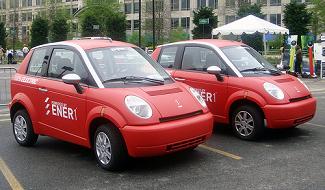Electric cars
Electric cars are powered by the engine or electric motor. All vehicles of this type are marked with the abbreviation EV - electric vehicle, electric drive vehicle. Electric cars will help to reduce emission of exhaust fumes in the cities. They usually gain energy from the car batteries (lead acid, nickel hydrogen, lithium ionic battery; Zebra). The problem of high prices of car batteries and its recycling after its exploitation in the era of improving the technology of its production gradually disappears.
Today, oil prices reach $ 100 per barrel. Forecasts are not good – soon there will be no oil, so it will be more expensive. Cars with electric drive are an ideal alternative to fuel burning vehicles. These cars have a very high efficiency and simple construction. Providing energy to such a vehicle is a more economical process than providing fuel to internal combustion engine cars. Electric cars are able to regain electrical energy from braking and in the same time reduce brake wear. It is also very ecological solution.

The European Commission in March 2011 adopted Transport 2050 strategy. It assumes that by 2050 all conventionally powered cars will have disappeared from the roads. They will be replaced by hybrid or electric cars. The Union has also issued rules establishing emission limit by internal combustion engines. Additionally, it gives grants to those who have already decided to purchase an electric car.
Electric cars are vehicles which are becoming more and more popular in the whole world. They are the most popular in China and Turkey. Buying an electric car is an expense of nearly 15 000 euro.
The history of electric vehicles dates back to the nineteenth century. The first crude electric carriage was invented by a Scottish businessman Robert Anderson, somewhere between 1832 and 1839. Two Frenchmen Gaston Plante (1865) and Camille Faure (1881) were people who improved the car batteries in electric vehicles. The first countries that supported the development of electric vehicles were France and Britain.
Ecological, environmental non-polluting electric cars were popular until 1900. In 1899,Camille Jenatzy exceeded the limit of 100 km / h of speed in such a vehicle..
At the beginning of the twentieth century, an electric cars manufactured by Edison, Anthony, Detroit, Baker and Studebaker were replaced by cars with internal combustion engines. This happened because of technological limitations of then technology of electrical power engineering, which resulted in low speed of these vehicles (about 32 km / h).
Electric cars were directed mostly to wealthy people, particularly for women (low noise, ease of use, cleanliness). Electric drive did not require considerable physical strength, even at starting crank.
Constant development of the car with a combustion engine led to displacement of their electric competitors. Also technological deficiencies contributed to the collapse of electric vehicles (not fully ascertained rectifiers necessary to use direct current) Next factor was still developing oil lobby.
In 1947 there was a turning point in the history and use of electric cars. The first transistor was constructed than at Bell Telephone Laboratories. Its inventors (J. Bardeen, W.H. Brattain, W.B. Shockley) were granted with the Nobel Prize for Physics in 1956.
When it came to the fusion of the National Union Electric Company (manufacturer of Exide batteries) with Henney Motor Company coachwork division, the first modern electric car based on transistor technology was created. Henney Kilowatt made vehicles with a circuits of voltage of 36 and 72 volts. Models with 72 volts achieve higher speed (up to 96 km / h), and drive for an hour on a single charge. Unfortunately, the production of these vehicles was too expensive and it was finished in 1961.
In the 80s of the twentieth century, electric cars were reborn again and found to be excellent vehicles that were not emitting pollution. Then arose, among others: GM EV1, HondaEV Plus, Toyota RAV4 EV. Today there is a continuous increase in the number of electrically powered vehicles.
Examples of vehicles converted to electric powere are: Daihatsu Chara de, BiuckRegal, Toyota Corolla, Daewoo Nexia.
The latest models of electric cars are race cars, electric AC 03 Evo2, electric go-kart Linde E1; sports Oullim Spirra EV electric Beetle Black ;Curren; Luxgen Neora, Swiss Lampo3; racing Nissan Nismo RC Leaf, Nissan Leaf, Croatian VST BMW, Audi A3 e -throne; little Mia Electric or C-ZEN, Tesla Roads ter, German, sports Artega SE; Renault Kangoo ZE-light Maxi van (go into production in autumn 2011);eRuf Porsche 997 Carrera, Toyota iQ EV Porsche Boxster E ; BMW ActiveE, BYDe6-Eco, Li-ion Inizio Motors,&nb sp;Ford Focus Electric.